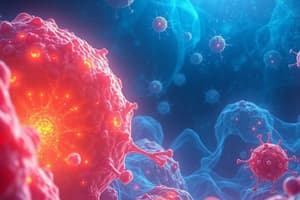Podcast
Questions and Answers
What cellular process maintains balance when physiological demands, cell structure, and metabolic capacity are in equilibrium?
What cellular process maintains balance when physiological demands, cell structure, and metabolic capacity are in equilibrium?
- Homeostasis (correct)
- Metaplasia
- Hyperplasia
- Atrophy
Which type of cellular adaptation involves an increase in the number of cells in a tissue or organ?
Which type of cellular adaptation involves an increase in the number of cells in a tissue or organ?
- Metaplasia
- Atrophy
- Hypertrophy
- Hyperplasia (correct)
What term describes the cellular adaptation where one adult cell type is replaced by another to better handle stress?
What term describes the cellular adaptation where one adult cell type is replaced by another to better handle stress?
- Dysplasia
- Hypertrophy
- Atrophy
- Metaplasia (correct)
Which of the following is the best example of physiologic hyperplasia?
Which of the following is the best example of physiologic hyperplasia?
Why does hypertrophy, rather than hyperplasia, occur in nerve, heart, and skeletal muscle cells?
Why does hypertrophy, rather than hyperplasia, occur in nerve, heart, and skeletal muscle cells?
What is the main characteristic of atrophy?
What is the main characteristic of atrophy?
Which of the following conditions can lead to cellular atrophy?
Which of the following conditions can lead to cellular atrophy?
In what way is metaplasia considered an adaptive change?
In what way is metaplasia considered an adaptive change?
What is the most common example of metaplasia?
What is the most common example of metaplasia?
What distinguishes reversible injury from irreversible injury at the cellular level?
What distinguishes reversible injury from irreversible injury at the cellular level?
Which of the following is a cause of cell injury related to nutritional imbalances?
Which of the following is a cause of cell injury related to nutritional imbalances?
What is the primary effect of hypoxia on cells?
What is the primary effect of hypoxia on cells?
What is the underlying cause of cell injury in cases of ischemia?
What is the underlying cause of cell injury in cases of ischemia?
Why is carbon monoxide (CO) poisoning considered a cause of cell injury?
Why is carbon monoxide (CO) poisoning considered a cause of cell injury?
What is the critical factor that determines whether a cell injury is reversible or irreversible?
What is the critical factor that determines whether a cell injury is reversible or irreversible?
In pathologic hyperplasia, what happens if the causative stimulus is removed?
In pathologic hyperplasia, what happens if the causative stimulus is removed?
What is the primary difference between physiologic and pathologic hypertrophy?
What is the primary difference between physiologic and pathologic hypertrophy?
How can metaplasia potentially increase the risk of cancer development?
How can metaplasia potentially increase the risk of cancer development?
What are the two main morphologic patterns of cell death?
What are the two main morphologic patterns of cell death?
Which of the following is an example of cell injury caused by a physical agent?
Which of the following is an example of cell injury caused by a physical agent?
Flashcards
Cellular Balance
Cellular Balance
To function normally, cells require balance between physiological demands, structure and metabolic capacity.
Homeostasis
Homeostasis
When cells face mild stress, they adjust to maintain equilibrium.
Adaptation
Adaptation
An adaptive response where cells change in response to stress, remaining viable.
Hyperplasia
Hyperplasia
Signup and view all the flashcards
Hypertrophy
Hypertrophy
Signup and view all the flashcards
Atrophy
Atrophy
Signup and view all the flashcards
Metaplasia
Metaplasia
Signup and view all the flashcards
Hyperplasia definition
Hyperplasia definition
Signup and view all the flashcards
Hypertrophy definition
Hypertrophy definition
Signup and view all the flashcards
Physiologic Hyperplasia
Physiologic Hyperplasia
Signup and view all the flashcards
Pathologic Hyperplasia
Pathologic Hyperplasia
Signup and view all the flashcards
Hypertrophy definition
Hypertrophy definition
Signup and view all the flashcards
Increased functional demand
Increased functional demand
Signup and view all the flashcards
Atrophy
Atrophy
Signup and view all the flashcards
Causes of atrophy
Causes of atrophy
Signup and view all the flashcards
Metaplasia
Metaplasia
Signup and view all the flashcards
Reversible Injury
Reversible Injury
Signup and view all the flashcards
Irreversible Injury
Irreversible Injury
Signup and view all the flashcards
Morphologic patterns of cell death
Morphologic patterns of cell death
Signup and view all the flashcards
Causes of Cell Injury
Causes of Cell Injury
Signup and view all the flashcards
Study Notes
- To function correctly, cells need balanced physiologic demands, cellular structure, and metabolic capacity, called homeostasis
- Cells can adjust their function when faced with mild stress to maintain balance
- Excessive or harmful stress can lead to Adaptation, Reversible Injury, Irreversible Injury, or Cell Death
Adaptation
- Occurs when cells respond to stress from normal or abnormal factors
- Cells change but remain viable via:
- Hyperplasia: Increase in cell number
- Hypertrophy: Increase in cell size or mass
- Atrophy: Decrease in cell size or function
- Metaplasia: Change in cell type or structure for better stress handling
Hyperplasia
- Means an increase in the number of cells in a tissue or organ
- Often occurs with hypertrophy (cells getting bigger)
- Occurs only in cells that can divide such as epithelial, blood-forming, and connective tissue cells
- Nerve, heart, and skeletal muscle cells can't divide and grow by hypertrophy when under stress or hormone stimulation
- Hyperplasia can be physiologic (normal) or pathologic (abnormal)
Physiologic Hyperplasia Types
- Hormonal Hyperplasia such as the growth of breast glands during puberty and pregnancy
- Compensatory Hyperplasia such as liver cells multiplying after partial hepatectomy (removal of part of the liver)
Pathologic Hyperplasia Types
- Caused by excessive hormone stimulation shown in hyperestrinism leading to atypical endometrial hyperplasia
- Caused by local growth factors as is seen in the overgrowth of connective tissue cells during wound healing
- In pathologic hyperplasia, removing the stimulus usually resolves extra cell growth
- However, it can create a high-risk environment for cancer development
Hypertrophy
- Involves an increase in cell size, which leads to a bigger organ or tissue
- Can be physiologic (normal) or pathologic (abnormal)
- Increased functional demand such as muscle growth in bodybuilders, or heart muscle thickening in heart disease
- Hormonal stimulation such as Uterine hypertrophy during pregnancy due to hormonal changes
Atrophy
- Shrinkage in cell size due to loss of cell substance
- Causes of atrophy include:
- Decreased workload
- Loss of innervation
- Diminished blood supply
- Inadequate nutrition
- Loss of endocrine stimulation
- Aging
Metaplasia
- A reversible change where one adult cell type is replaced by another type (either epithelial or mesenchymal) for better stress handling
- Most common example: Columnar to squamous cell change in the respiratory tract, seen in smokers due to chronic irritation (squamous metaplasia)
- While usually benign, continued harmful stimuli can lead to atypical metaplasia, potentially leading to cancer
- Can happen in mesenchymal cells like fibroblasts changing into osteoblasts or chondroblasts
- This can lead to bone or cartilage forming in unusual places
Reversible Injury
- Cell damage can return to normal if the cause is removed or is mild
- The structure and function of the cell can still recover
Irreversible Injury
- Irreversible damage is too severe or prolonged
- The cell can’t recover and will die
- Usually by necrosis or apoptosis
- There are two morphologic patterns of cell death: Necrosis and Apoptosis
Causes of Cell Injury
- Oxygen Deprivation (Hypoxia): Reduces ATP production, leading to cell damage
- Ischemia (Loss of blood supply)
- Poor oxygenation (heart or lung failure)
- Loss of oxygen-carrying capacity (anemia, carbon monoxide (CO) poisoning)
- Physical Agents such as trauma, heat, cold, radiation, and electric shock
- Chemical Agents & Drugs such as poisons, therapeutic drugs, pollutants, alcohol, and narcotics
- Infectious Agents such as viruses, bacteria, fungi, and parasites
- Immunologic Reactions such as autoimmune diseases attacking the body's own cells
- Genetic Derangements such as chromosome abnormalities and gene mutations
- Nutritional Imbalances such as deficiencies (protein, vitamins) or excess (obesity)
Studying That Suits You
Use AI to generate personalized quizzes and flashcards to suit your learning preferences.




